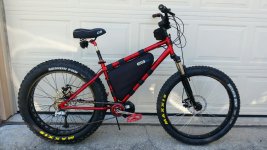First, no offense taken by anyone that doesn't agree with me so feel free to express your opinions...I might learn something.
There was a discussion earlier on brakes and I came across something on the Luna Cycles site that I thought I should post since it isn't my opinion but info from one of the biggest ebike sellers around. For a donor bike, they recommend:
Consider spending more money on your donor bike. If you use cheap components and add high power, it can be a dangerous combination…things you might want to consider:
Disc brakes are a must…preferably high quality
Full suspension is cool but difficult to mount, plus battery and frame might flex
Consider a hardtail downhill bike…the most practical donor solution
Quality ebike tires are a must, preferably DOT speed rated
High quality derailleur and shifters are needed to survive with high power
Some more data...here is a statement for the renowned Sheldon Brown "For bicycles used on-road, the advantages of disc brakes aren't as compelling.". Just wanted to point out that disc brakes aren't always the best choice.
And if you are having trouble deciding what is best for your applications, read this well written article, although it is intended for Road Bikes, the information applies to all two wheelers: https://blog.performancebike.com/2015/01/06/road-bikes-rim-brakes-vs-disc-brakes/
OK now that I beat that dead horse again and again, back to the fun stuff....
I have just ordered a Mongoose Terrex (my third) and a Mongoose Hitch (my first fat bike). I will be changing forks and brakes on both bikes before I ride them with electric motors. The Terrex is going to be built to go do some downhill riding this summer at a ski resort. Plan to install a DNM-USD8 fork, 27.5x3.00 Maxxis High Roller in the rear and a 27.5x2.8 Maxxis DHF in the front. Brakes will be 203 mm in the rear and the largest the DNM is rated to allow in the front. I have a lot of off road miles on the two other Terrexs...one with a MAC and one with a BBSHD. No problems to date other than they aren't the lightest bikes around

. Both come in right around 65 lbs with a 14s6p battery. I have Shimano hydraulic disc brakes with 203 mm rotors on the rear and 180 mm on the front. Only reason I didn't go 203 on the front is the XCR forks I am using are not rated for anything larger than 180. The XCR forks work fairly well...I'd rate them a best bang for the buck. You can get forks that are much better but they are going to cost a lot more too...my XCRs were $100-$125 each.
The new Hitch is going to either get a BBSHD or a Cyclone kit...still trying to decide. Tried to buy a Ludicrous controller from Luna and they turned me down. Seems you have to spend some big bucks (IMO) with them before you can buy the good parts and if I have to go to an external controller then the cleanliness of the BBSHD installation is compromised and the Cyclone starts to look more attractive.
Just wanted to provide a little update on my STEEL FRAMED, DISC BRAKE builds

....and yes I am a lot prejudice but that doesn't mean my choices are best for you. If you are having fun, nothing else matters.




